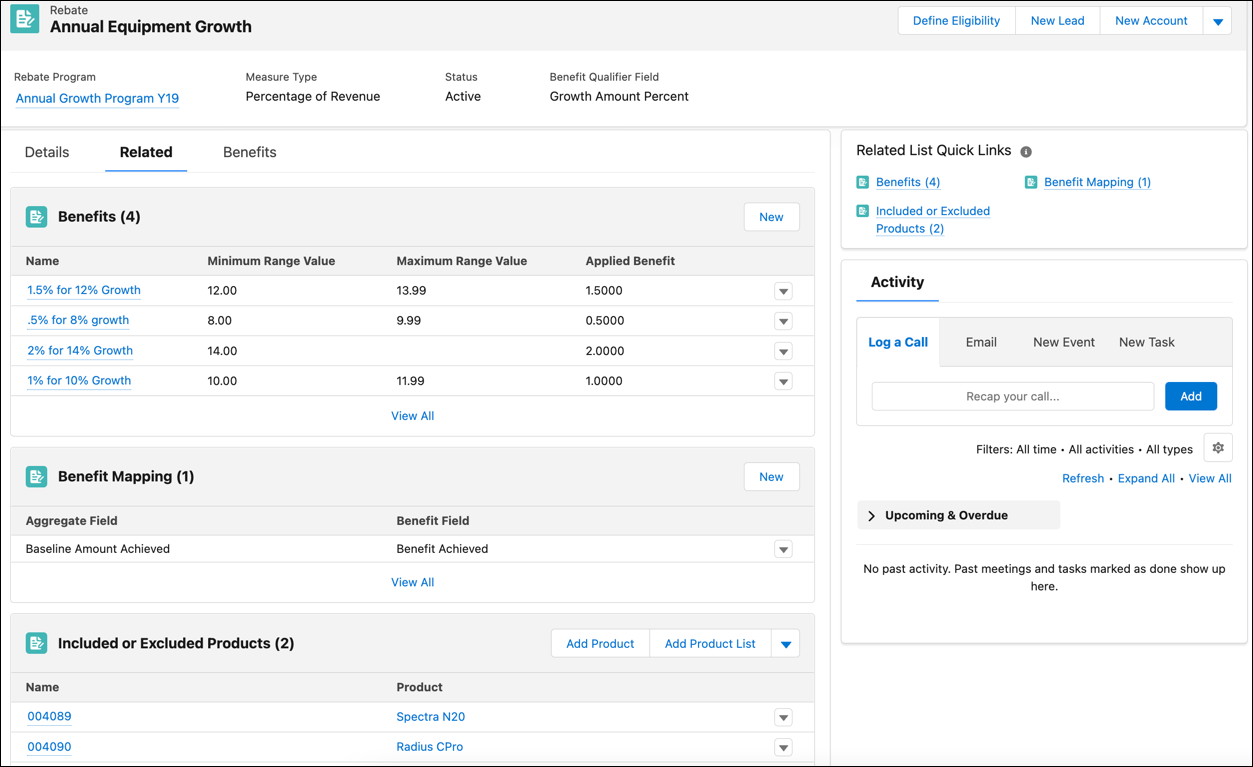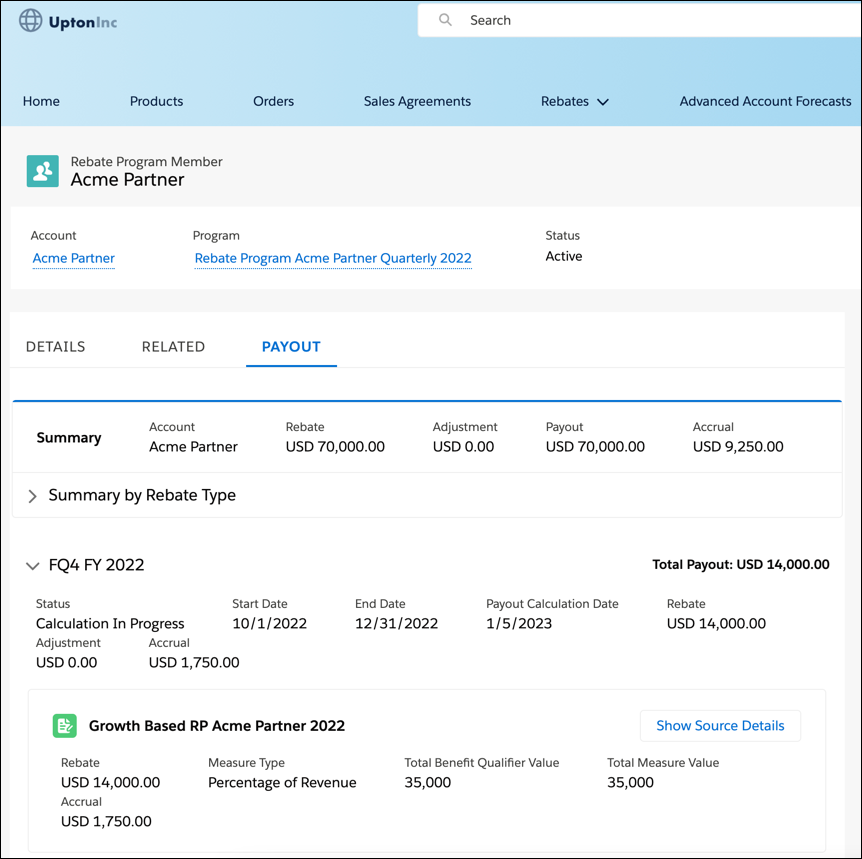Strengthen Relationships with Partners
Learning Objectives
After completing this unit, you’ll be able to:
- Explain why efficient visits to partners bring greater alignment.
- Outline the benefits of creating rebate programs.
- Describe how a Manufacturing Experience Cloud site helps manufacturers collaborate meaningfully with partners.
Optimize Visit Management and Execution
In the manufacturing industry, close coordination with partners can be the difference between just keeping the lights on and taking the market by storm. One way to collaborate closely with partners is to visit them, in person.
Account managers at Rayler Parts organize field rep visits to dealers, distributors, and suppliers to boost collaboration on production, sales, and distribution. Here are some tasks field reps can do during a visit.
- Align on sales agreements, orders, and brand-promotion campaigns.
- Monitor partner performance.
- Conduct periodic check-ins.
- Audit products in inventory.
- Train partners.
- Upsell and cross-sell products.
- Follow up on sales agreements and warranty renewals.
With efficient and frequent visits, account managers can build mutual trust and deeper relationships with their partners. Unfortunately, managing numerous field reps and organizing visits to various partners can stump even the best account managers. Elliott asks Cindy if Manufacturing Cloud can help organize visits and capture information during visits.
Cindy introduces Elliott to Partner Visit Management, a versatile framework for managing and tracking visits. With Partner Visit Management, account managers can organize and assign visits to field reps. This includes defining visit tasks, like renewing a sales agreement or meeting a warehouse supervisor. They can also specify key performance metrics with target values, like the number of spare parts in the inventory. Here’s an example visit action plan.

Field reps can use the Salesforce mobile app to view the list of assigned visits, navigate to a visit location, check tasks to be done, make notes, and capture key metrics. Here’s a visit open in the Partner Visit mobile app.

After a visit, all this information is stored in your Salesforce Org where account managers can analyze it and determine the next actions.
To learn more, see Build Distributor Relationships with Partner Visit Management.
Incentivize Partners with the Cherry on Top
Retaining partners for the long haul can be tough, Elliott tells Cindy. To build long-term relationships and drive the desired channel purchasing behavior, Rayler Parts gives rebates to its partner distributors and dealers.
Rebates are monetary incentives that reward partners when they achieve a certain threshold of revenue, orders, growth, or any other target. Manufacturing, retail, and other industries give rebates to distributors and dealers to increase sales and encourage repeat business.
To manage rebates, Elliott needs to set up rebate programs, define program eligibility and rewards, track rebate attainment, calculate payouts, and communicate targets and payouts to partners. With the increasing number of rebate programs, he wonders if there’s a way to effectively scale their rebate process.
Cindy introduces Elliott to Rebate Management, an add-on app that empowers rebate program managers to orchestrate the entire rebate lifecycle, from program creation to sending rebate payouts to members. Here’s an example of a program rebate type.

Rebate program managers can easily create rebate programs and define their eligibility criteria and payout schedules. They can create different rebate types, based on growth, revenue, or volume, and design multitier target and benefit structures. For example, a growth-based rebate type can have the following structure.
- 2–4% annual revenue growth: $2,000 rebate
- 5–7% annual revenue growth: $3,000 rebate
- More than 7% annual revenue growth: $4,000 rebate
Rebate program managers can:
- Configure Data Processing Engine to automatically pull out transaction data from different objects, aggregate the transactions, and calculate the rebate payouts.
- Use flows and batch jobs to schedule the aggregation of transactions and the calculation of payouts.
- Audit transactions and adjust payout amounts.
Once payouts are finalized, they can use their ERP system to send the payouts to partners and track the rebate payments in the app.
Finally, rebate program managers can collaborate with partners on transactions, rebate attainment, and payouts using the Manufacturing Experience Cloud site. Here’s a rebate program member in a Manufacturing Experience Cloud site.

Admins can go a step further and integrate rebates into the sales process. Here’s an example of the Rebates panel on an Account record page.

Account executives can see the eligible and applied rebates for a contract, account, or quote, as well as rebate attainment progress and potential rebates from a higher benefit tier. With this, they can prevent incentive overpayments, shape rebate types for specific partners, and nudge partners towards more orders.
To optimize rebate programs, track business goals, and analyze member performance, rebate program managers can use CRM Analytics for Manufacturing Cloud. It provides preconfigured dashboards with actionable insights into rebate types, tiers, payouts, product sales, and more.
To learn more, see Rebate Management Basics.
Enter a Brand New Experience
As you saw earlier, Cindy can create a branded, responsive digital site to collaborate with partners using Experience Cloud. Here’s a Manufacturing Experience Cloud site open in the Experience Builder.

Cindy quickly set up a site for Rayler parts using the preconfigured Experience Cloud template that comes with Manufacturing Cloud. She can customize the site further and control visibility and access to the entire website, specific pages, and records.
A manufacturing Experience Cloud site can empower Elliott’s team to streamline account management and collaborate on sales agreements, leads, and partner orders. They can also give partners visibility into advanced account forecasts and rebate programs.
To learn more, see Set Up Experience Cloud Sites for Manufacturing.
In the next unit, you explore how Manufacturing Cloud can help make the teams at Rayler Parts more productive and tap into customer data for insights.
Resources
- Salesforce Help: Get Help for Salesforce Rebate Management
- Trailhead: Unified Sales and Rebate Management Processes